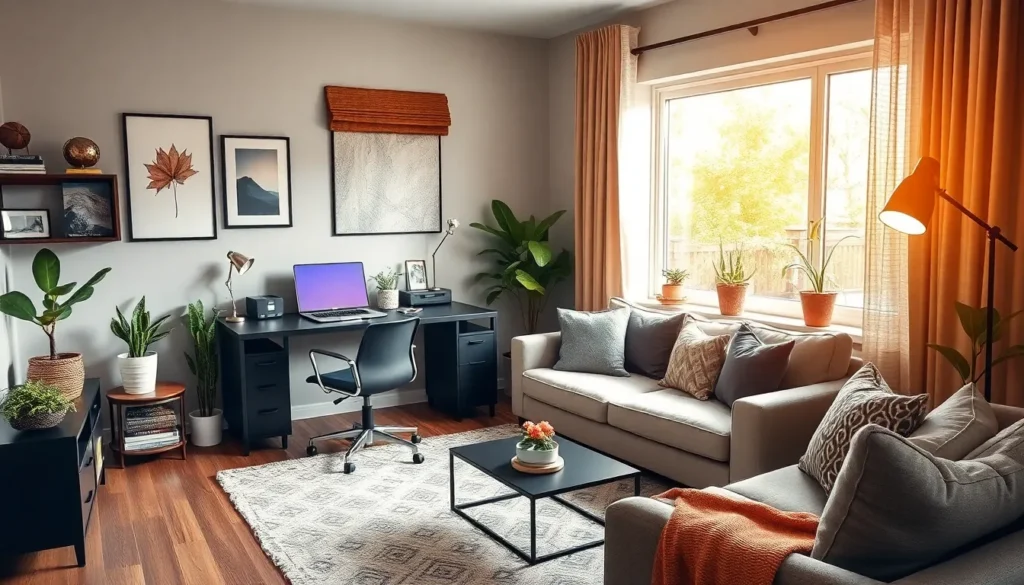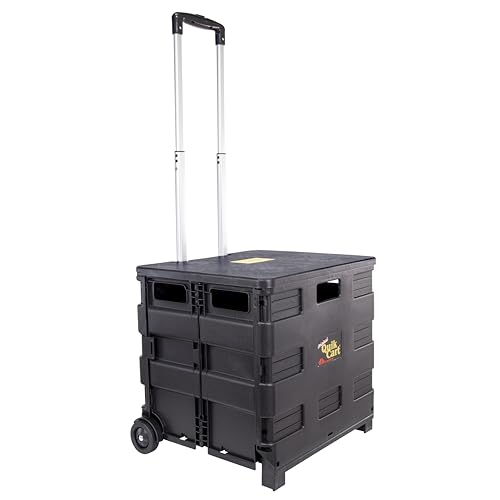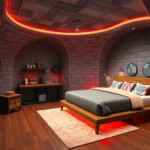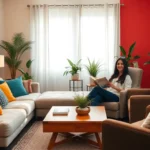Working from home has become our new reality and we’re all scrambling to create productive workspaces in less-than-ideal situations. If you’re like most of us your living room has suddenly become prime real estate for that much-needed home office setup.
The challenge? Creating a functional workspace that doesn’t completely overtake your relaxation zone. We’ve discovered that with the right strategies you can seamlessly blend your office needs with your living room’s comfort and style. It’s all about smart design choices that maximize both productivity and livability.
Whether you’re dealing with a cramped apartment or an open-concept home we’ll show you how to transform any corner of your living room into an efficient workspace. From clever storage answers to dual-purpose furniture these ideas will help you create the perfect work-life balance right in your own living space.
Create a Dedicated Corner Workspace
Corner spaces offer the perfect opportunity to establish a productive home office zone without overwhelming your living room’s primary function. We’ll show you how to transform an underutilized corner into a functional workspace that seamlessly integrates with your existing decor.
Choose the Right Corner Location
Natural light makes the biggest difference in creating an energizing workspace, so we recommend selecting a corner near a window whenever possible. Position your desk at an angle to avoid glare on your computer screen while still benefiting from daylight throughout the day.
Traffic flow through your living room determines whether a corner will work effectively for focused tasks. We suggest avoiding high traffic areas near doorways or pathways to the kitchen, as constant movement can disrupt concentration and video calls.
Electrical outlets play a crucial role in corner workspace functionality since you’ll need power for computers, lamps, and charging stations. Choose corners with existing outlets to avoid running extension cords across walking areas, which creates both safety hazards and visual clutter.
Use a Corner Desk Solution
L shaped desks maximize corner real estate by providing ample surface area for multiple monitors, documents, and office supplies. We’ve found that these configurations work particularly well in corners measuring at least 6 feet by 6 feet, giving you enough room to move your chair comfortably.
Floating corner shelves create a minimalist desk alternative that doesn’t overwhelm smaller living spaces. Mount a triangular shelf at standing desk height (42 inches) or traditional desk height (30 inches) depending on your work preferences and existing furniture scale.
Modular desk systems adapt to corner spaces of any size while offering flexibility for future room rearrangements. We recommend starting with a basic corner unit and adding components like keyboard trays, monitor stands, or side extensions as your workspace needs evolve.
Add Vertical Storage Options
Wall mounted shelves above your corner desk provide essential storage without consuming valuable floor space in your living room. Install floating shelves at 18 to 24 inches above your desk surface to keep frequently used items within easy reach while maintaining an organized appearance.
Corner ladder shelves offer a stylish storage solution that complements both modern and traditional living room aesthetics. These units typically measure 65 to 75 inches tall and provide 4 to 5 shelf levels for books, binders, decorative storage boxes, and plants.
Pegboard systems transform vertical wall space into customizable storage that grows with your home office needs. We suggest painting pegboards to match your wall color for a seamless look, then adding hooks, baskets, and small shelves to organize supplies, headphones, and charging cables.
Design a Room Divider Office Setup
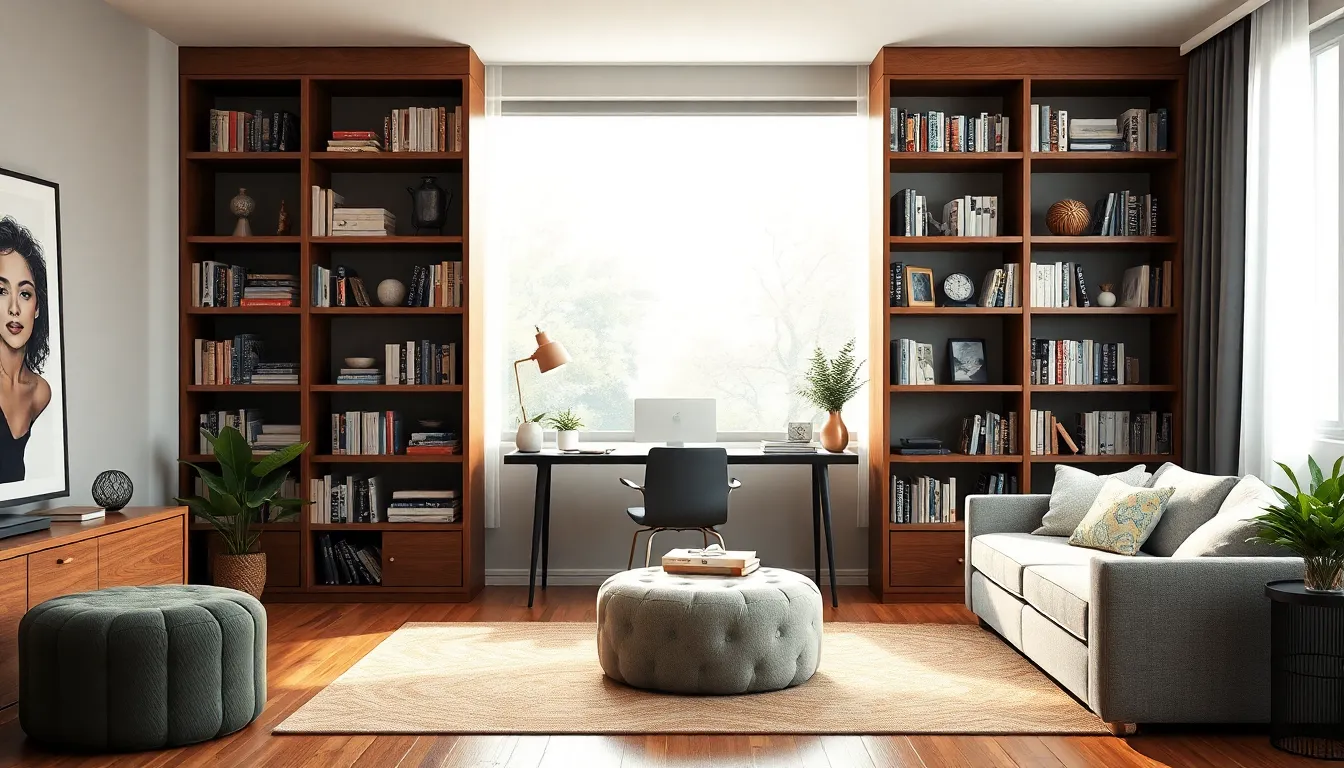
Creating distinct zones within your living room transforms your space into a functional dual-purpose area. Room divider office setups offer the perfect solution for maintaining privacy while preserving your living room’s open feel.
Install Bookshelf Room Dividers
Bookshelf dividers serve as the most practical room separation solution for home offices. Floor-to-ceiling bookshelves create a clear workspace boundary while providing essential storage for books, binders, and office supplies. We recommend choosing units with varying shelf heights to accommodate different items like decorators, plants, and work materials.
Open-back bookcases maintain visual flow between spaces while still defining your office area. These dividers allow natural light to filter through both zones, preventing your living room from feeling cramped or dark. Position your bookshelf perpendicular to the wall to maximize storage capacity and create a substantial workspace barrier.
Modular bookshelf systems offer flexibility as your needs change over time. You can easily reconfigure these units by adding or removing sections to adjust your office size. Many modular options include desk attachments that integrate directly with the shelving system for a cohesive look.
Use Curtains or Screens for Privacy
Curtains provide the most versatile privacy solution for living room offices. Ceiling-mounted track systems allow you to easily slide curtains open during leisure time and close them for focused work sessions. We suggest selecting medium-weight fabrics that reduce noise while maintaining some light transmission.
Room screens offer immediate privacy without permanent installation requirements. Folding screens with three to four panels create substantial workspace separation while remaining easily movable. Japanese-style shoji screens add elegance while diffusing light beautifully throughout both areas.
Hanging curtain panels from the ceiling creates a dramatic office enclosure effect. Choose fabrics that complement your existing living room decor to maintain visual harmony. Blackout curtains work exceptionally well for video calls, eliminating distracting background elements completely.
Position Furniture to Create Natural Boundaries
Strategic furniture placement establishes clear office boundaries without blocking room flow. Console tables positioned behind your sofa create a natural workspace ledge while maintaining conversation areas. This arrangement works particularly well in open-concept living rooms where space definition is crucial.
Sofas themselves become excellent office dividers when positioned perpendicular to walls. Place your desk behind the sofa to create a secluded workspace that feels separate from entertainment areas. This setup allows you to maintain visual connection with the living space while establishing work boundaries.
Storage ottomans serve dual purposes as office dividers and functional furniture pieces. Position multiple ottomans in a line to create workspace separation while providing additional seating for guests. These multipurpose pieces offer hidden storage for office supplies, keeping your living room clutter-free.
Build a Murphy Desk Configuration
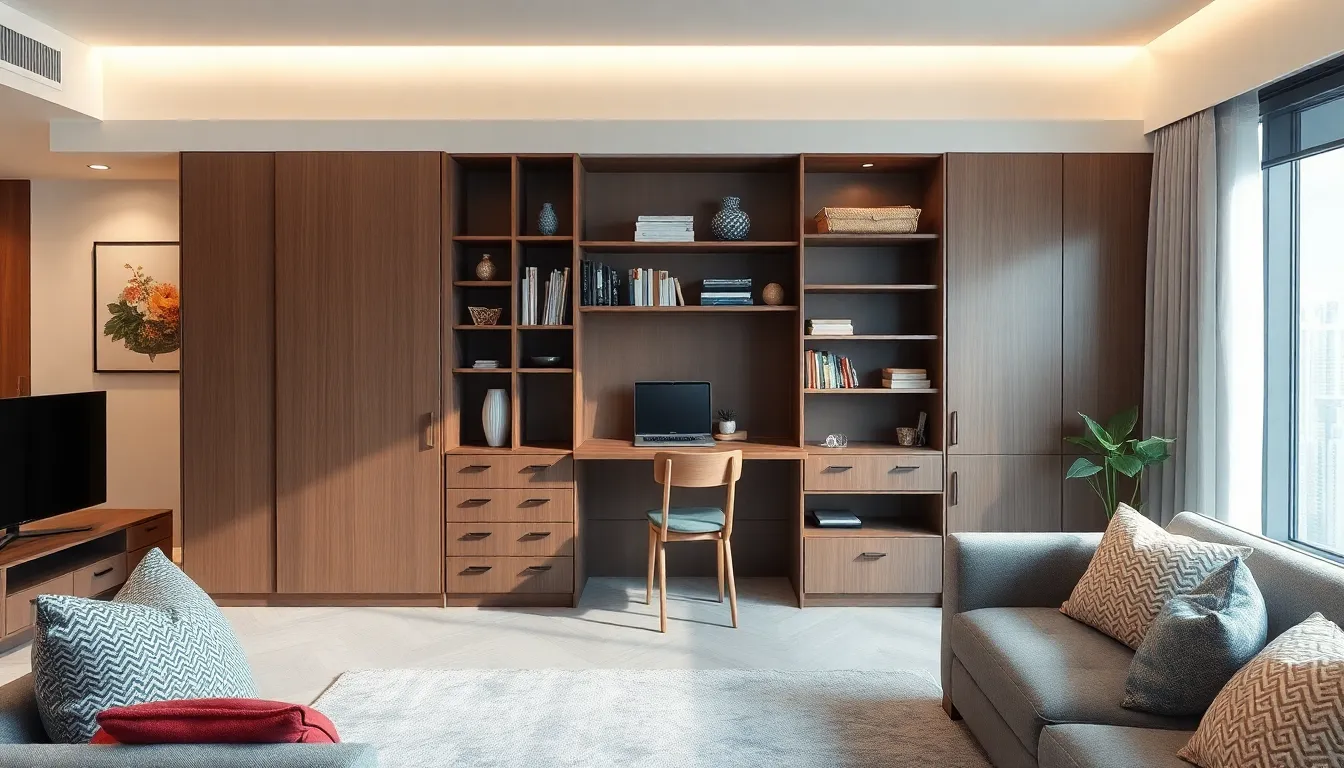
Murphy desks offer an elegant solution for creating a home office in your living room without permanently sacrificing valuable floor space. This wall-mounted workspace seamlessly transitions between office mode and living room relaxation, making it perfect for maintaining our room’s dual functionality.
Select Wall-Mounted Folding Options
Wall-mounted desks provide the foundation for our Murphy desk setup while maintaining minimal visual impact in the living room. Drop-leaf surfaces offer quick access to a work area that folds flat against the wall when we’re not using it. These vertical configurations keep our living space open for family activities and entertaining guests.
Modular wall systems give us flexibility to customize our desk height and storage according to our exact needs. We can install these systems at the perfect ergonomic level for comfortable work sessions. The sleek profiles blend seamlessly with existing decor themes, from modern minimalist to traditional styles.
Consider installing a fold-down desk with integrated cable management to keep our workspace organized and clutter-free. These units often include built-in cord holes and wire channels that hide unsightly cables when the desk is in use.
Install Hidden Storage Compartments
Hidden storage maximizes our organizational capabilities without cluttering the living room’s visual appeal. Under-desk drawers slide out when we need office supplies and disappear completely when the Murphy desk folds up. These compartments keep documents, stationery, and electronics within easy reach during work hours.
Built-in wall cabinets above or beside our Murphy desk create additional storage for books, files, and personal items. We can design these cabinets to match our living room’s existing cabinetry for a cohesive look. Concealed shelving maintains our room’s clean aesthetic while providing ample space for work essentials.
Modular storage cubes offer versatility for changing organizational needs throughout different work projects. These units stack or arrange in various configurations to accommodate everything from printer paper to reference materials. Interior dividers help us categorize items efficiently within each storage compartment.
Choose Compact Folding Chairs
Lightweight folding chairs complement our Murphy desk setup by disappearing when we’re not working. These portable seating options store easily in closets, under beds, or behind furniture without taking up permanent living room real estate. Slim profile designs ensure our chairs don’t dominate the space when we bring them out for work sessions.
Ergonomic folding models provide proper back support during extended work periods while maintaining their space-saving benefits. We can select chairs with padded seats and adjustable features that rival traditional office furniture. Quality construction ensures these chairs remain comfortable and durable even though frequent folding and unfolding.
Stackable options multiply our seating capacity for video conferences or collaborative work sessions with family members. Two or three chairs nest together in minimal storage space, ready when we need extra seating. Neutral colors and contemporary designs help these functional pieces blend naturally with our living room’s existing furniture palette.
Establish a Behind-the-Sofa Office Zone

Creating a workspace behind your sofa transforms underutilized space into a productive home office area. This strategic placement maintains your living room’s flow while establishing a dedicated work zone.
Position a Console Table Workspace
Selecting the right console table serves as your desk foundation for this behind-the-sofa office setup. We recommend choosing tables with built-in storage drawers or shelves to house office supplies and keep your workspace organized. Standard console tables typically measure 30-36 inches in height, providing an ideal desk surface that won’t obstruct your sofa’s back view.
Measuring your available space ensures you’ll find the perfect fit for your console table desk. Narrow profiles work best in tighter spaces, with widths ranging from 12-18 inches deep allowing comfortable laptop use without overwhelming the area. Console tables with lower shelving provide additional storage for books, files, or decorative items that complement your living room aesthetic.
Adding a stylish chair completes your behind-the-sofa workspace while maintaining visual harmony. Choose seating that matches your existing decor, such as upholstered accent chairs or sleek desk chairs that can easily tuck under the console when not in use. Rolling chairs offer mobility for quick transitions between work and relaxation modes.
Add Task Lighting Above the Sofa
Installing sconces above your sofa provides focused illumination for your behind-the-sofa office zone. Wall-mounted adjustable sconces eliminate the need for table space while delivering targeted light directly onto your work surface. Swing-arm models offer flexibility to direct light where you need it most during different tasks.
Positioning floor lamps creates ambient and task lighting without permanent installation requirements. Arc floor lamps work exceptionally well for this setup, curving over the sofa to illuminate your console table workspace. This lighting solution allows you to maintain your living room’s aesthetic while providing adequate work illumination.
Incorporating table lamps on your console table adds layered lighting options for various work activities. Small desk lamps with adjustable heads provide concentrated light for detailed tasks like reading documents or writing. LED options offer energy efficiency and cooler operation, preventing heat buildup in your living space.
Create Cable Management Answers
Using cable organizers keeps your behind-the-sofa office zone neat and professional looking. Adhesive cable clips attach to your console table’s underside, routing charging cables and power cords out of sight. Spiral cable wraps bundle multiple cords together, creating a cleaner appearance behind your workspace.
Installing cord concealers along your wall eliminates visible cable runs between outlets and your desk area. Paintable cord covers blend seamlessly with your wall color, maintaining your living room’s polished appearance. These answers work particularly well when your console table sits away from wall outlets.
Incorporating hidden storage answers keeps office supplies organized while concealing cable clutter. Storage baskets placed under your console table provide easy access to supplies while hiding power strips and cable excess. Decorative boxes on console shelves serve dual purposes, storing items while maintaining your living room’s style aesthetic.
Transform a Bay Window Into an Office Nook

Bay windows naturally create the perfect alcove for a home office workspace while preserving your living room’s primary function. We’ll show you how to maximize this architectural feature for both productivity and style.
Use Natural Light Advantages
Position your workspace directly within the bay window to optimize natural light exposure throughout the day. Natural lighting enhances mood and productivity while reducing dependence on artificial illumination. We recommend installing adjustable window treatments like blinds or shades to filter light without completely blocking it, preventing screen glare during work hours.
Consider the direction your bay window faces when planning your office setup. North-facing windows provide consistent, gentle light that’s ideal for computer work. South-facing windows offer abundant sunlight but may require more sophisticated light control answers.
Energy efficiency becomes a natural benefit when you position your desk near this abundant light source. We’ve found that workers report increased focus and reduced eye strain when their workspace takes advantage of optimal natural illumination.
Add Built-in Seating with Storage
Install cushioned seating along the bay window ledge to create a comfortable dual-purpose workspace. This built-in solution provides extra seating for your living room while serving as your primary work chair. Hidden drawers beneath the seating offer valuable storage for office supplies, files, and equipment without cluttering your living area.
Extend storage vertically with shelves or cabinetry around the bay window perimeter. These installations organize books, binders, and decorative items while maintaining the space’s aesthetic appeal. We suggest using materials that match your existing living room furniture for seamless integration.
Design the seating height to accommodate both work and relaxation activities. Standard desk height is 28-30 inches, so we recommend building your seating to complement a window-level desk surface for ergonomic comfort.
Install Window-Level Desk Surfaces
Mount your desk surface at window height to maximize natural light exposure while preserving sightlines throughout your living room. Floating or wall-mounted desks save valuable floor space and maintain a streamlined appearance that won’t overwhelm your living area.
Choose materials and finishes that complement your existing furniture for cohesive design integration. We recommend measuring your bay window’s dimensions carefully to create a custom-fitted desk that follows the window’s natural curve, maximizing your available work surface.
Consider adjustable-height options if multiple family members will use the workspace. Electric or manual height adjustment mechanisms allow the desk to serve various users while maintaining the clean lines essential for living room aesthetics.
Convert a TV Console Into Dual-Purpose Furniture
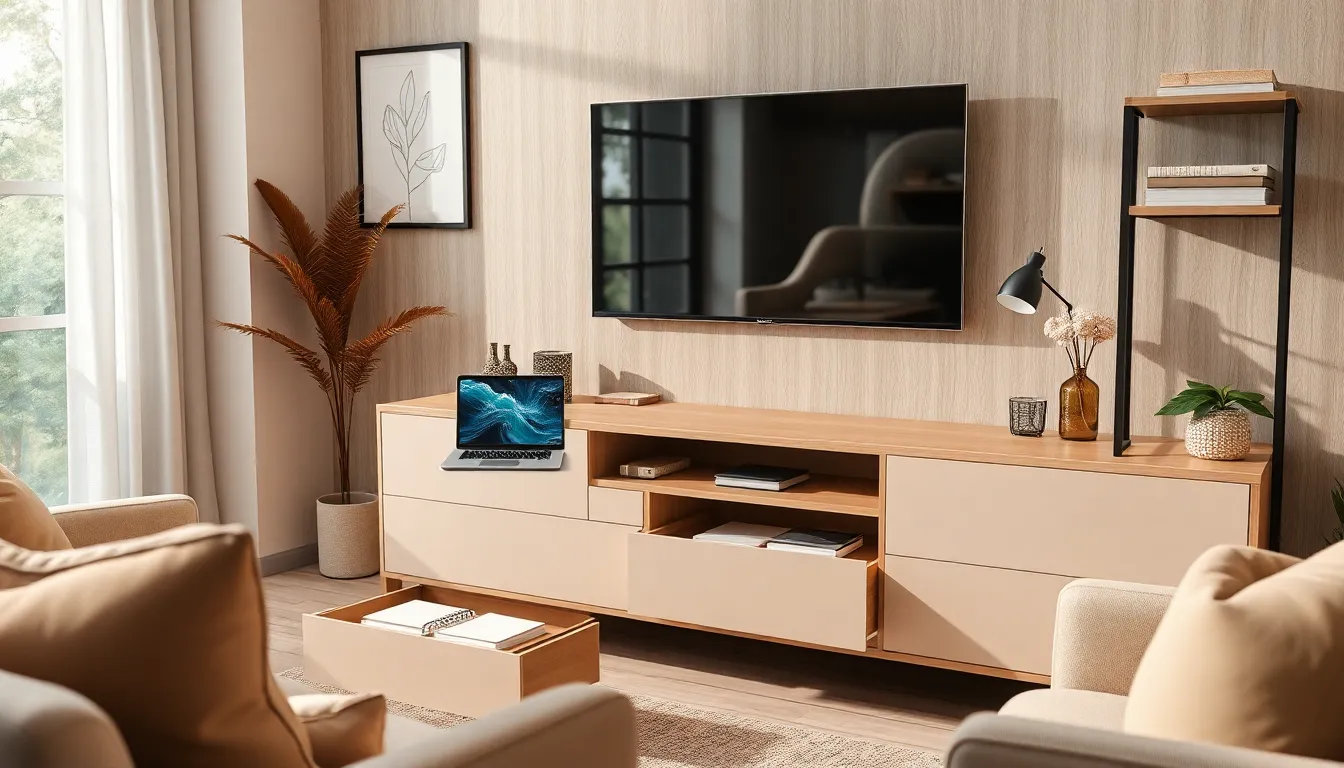
Repurposing your existing TV console creates an efficient workspace without disrupting your living room’s entertainment zone. We can transform this familiar furniture piece into a multifunctional hub that seamlessly blends productivity with relaxation.
Choose Media Centers with Desk Space
Media centers designed with integrated desk surfaces offer the perfect solution for combining work and entertainment needs. We recommend selecting TV stands that feature flat, spacious tops suitable for laptops and writing materials while maintaining their primary function as electronic device holders.
These dual-purpose pieces provide built-in storage compartments for both office essentials and media accessories. Modern media centers often include cable management systems that accommodate both work electronics and entertainment devices. We’ll find options that complement our existing living room decor while providing adequate workspace for daily tasks.
The key lies in choosing furniture that doesn’t overwhelm the room’s leisure function. Contemporary designs blend seamlessly with living room aesthetics while offering practical work surfaces that can be quickly cleared for movie nights or social gatherings.
Hide Office Supplies in TV Stand Drawers
Storage compartments within TV stands become invaluable for concealing work materials and maintaining visual harmony in our shared space. We can organize pens, notebooks, chargers, and documents in these existing drawers while keeping frequently used items within arm’s reach.
Drawer organizers help separate office supplies from entertainment accessories, creating designated zones within the same furniture piece. Small containers and dividers maximize storage efficiency while preventing work items from mixing with remote controls and gaming accessories.
This approach preserves our living room’s relaxed atmosphere by eliminating visual clutter associated with home offices. Quick access to materials becomes possible without sacrificing the room’s primary function as a comfortable gathering space.
Manage Cables for Both Functions
Effective cable organization becomes crucial when our TV console serves dual purposes, requiring management of both work electronics and media devices. We need systems that handle laptop chargers, monitor cables, and device connections alongside existing entertainment wiring.
Cable sleeves and clips attached behind furniture keep cords from both functions discreetly organized and easily accessible. Raceways can run along the back edge of consoles, creating dedicated pathways for different types of cables while maintaining a clean appearance.
Power strips with multiple outlets accommodate increased electrical demands from work equipment while keeping surge protection accessible. We should position these strips inside console cabinets or use cord concealers to maintain the furniture’s streamlined look while supporting both office and entertainment needs.
Design a Floating Desk Wall Setup
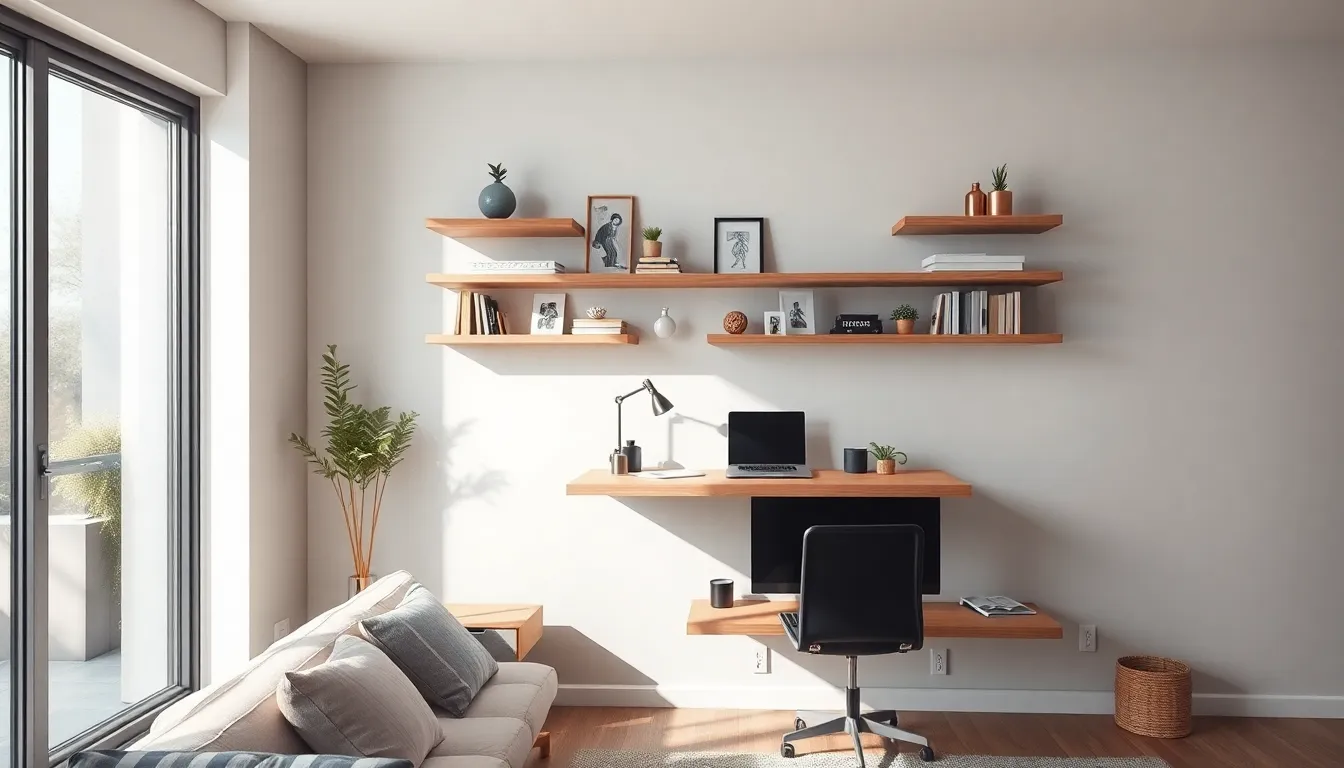
Floating desk configurations offer the ultimate space saving solution for creating a home office in your living room. These wall mounted systems provide a clean, modern aesthetic while maximizing floor space for your living area’s primary functions.
Install Wall-Mounted Desk Surfaces
Wall mounted desk surfaces transform any vertical space into an instant workspace without compromising your living room’s layout. We recommend selecting surfaces that fold up when not in use, allowing you to maintain the room’s entertainment function while hiding your work area completely.
Height considerations play a crucial role in wall mounted desk installation. Standard desk height ranges from 28 to 30 inches, but we suggest installing adjustable mounting systems to accommodate different users and tasks. Consider your seating options when determining the optimal height for productivity.
Weight capacity varies significantly between mounting systems. Most wall mounted desks support between 50 to 100 pounds, which accommodates laptops, monitors, and essential office supplies. We recommend checking your wall type and using appropriate anchors for maximum stability.
Material options include solid wood, engineered wood, metal, and glass surfaces. Each material offers different aesthetic benefits and load capacities. Wood surfaces provide warmth that blends with living room furniture, while glass creates a modern, minimalist appearance that won’t visually overwhelm the space.
Add Floating Shelves for Storage
Floating shelves above and beside your wall mounted desk create essential storage while maintaining the clean lines of your setup. These storage answers keep office supplies organized and easily accessible without adding visual clutter to your living space.
Strategic placement maximizes both function and aesthetics in your floating shelf configuration. We position shelves 12 to 18 inches above the desk surface to accommodate computer monitors while providing convenient access to frequently used items. Side mounted shelves offer additional storage for books, decorative items, and office essentials.
Load distribution across multiple shelves prevents sagging and maintains the clean appearance of your wall setup. Each floating shelf typically supports 20 to 40 pounds when properly installed with appropriate wall anchors. We recommend distributing weight evenly across all shelves rather than overloading individual units.
Aesthetic integration ensures your floating shelves complement both your workspace and living room decor. Matching shelf materials to your desk surface creates visual cohesion, while contrasting materials can add interesting design elements. We suggest incorporating a mix of functional storage and decorative items to maintain the living room’s welcoming atmosphere.
Create a Gallery Wall Above the Workspace
Gallery walls above floating desk setups serve as both inspiration and visual separation between work and relaxation zones. This design element helps define your workspace while adding personality that reflects your style and interests.
Artwork selection should balance professional inspiration with personal expression. We recommend mixing motivational quotes, abstract art, and personal photographs to create a gallery that energizes your workday while complementing your living room’s aesthetic. Consider pieces that coordinate with your existing color palette.
Layout planning ensures your gallery wall enhances rather than overwhelms your floating desk setup. We suggest sketching arrangements on paper first, then using removable adhesive strips to test layouts before committing to nail holes. Maintain consistent spacing of 2 to 3 inches between frames for visual harmony.
Lighting considerations highlight your gallery wall while providing task lighting for your workspace. We recommend installing small picture lights or strategically placed accent lighting to illuminate your artwork without creating screen glare. This dual purpose lighting enhances both the aesthetic appeal and functionality of your wall mounted office setup.
Implement a Rolling Cart Office Solution

A rolling cart transforms your living room into a flexible workspace without sacrificing style or functionality. We’ll show you how this mobile solution creates the perfect balance between productivity and home comfort.
Select Mobile Desk Cart Options
Choose carts with multiple compartments or drawers to maximize your storage potential while maintaining a compact footprint. We recommend models that feature adjustable shelves or surfaces, allowing you to accommodate laptops, monitors, and paperwork without overwhelming your living space.
Consider weight capacity and wheel quality when selecting your mobile desk cart. Look for carts that can support at least 50 pounds and feature smooth-rolling casters that won’t damage your flooring.
Evaluate surface materials that complement your existing decor such as wood-grain finishes for traditional living rooms or sleek metal designs for modern spaces. Some carts offer removable tops that can serve as lap desks when you’re working from your sofa.
Measure your available space carefully to ensure your chosen cart fits comfortably between furniture pieces. We suggest selecting models that are 24-30 inches wide to provide adequate workspace while remaining maneuverable in tight spaces.
Store Supplies in Cart Compartments
Organize office essentials like pens, paper, chargers, and notebooks in designated compartments to maintain a clutter-free living room environment. This systematic approach prevents work items from spilling onto your coffee table or entertainment center.
Use drawer organizers and small containers to create exact homes for different supply categories. We recommend clear containers so you can quickly locate items without rummaging through multiple compartments.
Keep frequently used items in top drawers while storing backup supplies and seasonal materials in lower compartments. This arrangement ensures your most essential tools remain easily accessible during work sessions.
Designate one compartment specifically for cables and chargers to prevent tangling and maintain a professional appearance. Consider adding velcro ties or cable organizers to keep electronic accessories neat and functional.
Move the Office as Needed
Relocate your workstation to different parts of the living room based on lighting conditions, noise levels, or personal comfort preferences throughout the day. This mobility allows you to chase natural light from your windows or find quieter spots during household activities.
Roll your cart to other rooms when you need complete privacy for important calls or deep focus work. The versatility means your office can move to a bedroom, dining room, or even outdoor patio as circumstances require.
Adjust your workspace position to avoid glare on your computer screen or to face away from television distractions. We find that positioning the cart at different angles helps create psychological separation between work and relaxation zones.
Store the entire office setup in a closet or behind furniture when you’re hosting guests or want to fully reclaim your living room for entertainment. This capability ensures your home maintains its welcoming atmosphere without permanent office intrusion.
Create a Closet Office Conversion

Converting an unused closet into a dedicated workspace offers an excellent solution for maximizing your living room’s potential while maintaining its primary function.
Remove Closet Doors for Open Access
Taking off closet doors instantly transforms your confined space into an inviting workspace. Removing these barriers creates better accessibility and makes the area feel more integrated with your living room environment. We recommend replacing traditional doors with curtains or sliding panels that complement your existing décor if you need occasional privacy or want to hide workspace clutter.
Privacy concerns become manageable with flexible screening options. Curtains provide an economical solution that allows you to close off the workspace when entertaining guests or during relaxation time. Sliding panels offer a more structured approach while maintaining the sleek appearance that blends seamlessly with your living room aesthetic.
Install Desk Surfaces Inside the Closet
Fitting a desk surface inside your closet maximizes the available width and depth for optimal workspace functionality. Custom-built desks offer the perfect fit for irregular closet dimensions while simple mounted shelves provide an affordable alternative at comfortable working heights. We suggest measuring your closet’s interior dimensions carefully to ensure your desk surface accommodates both your laptop and essential work materials.
Adding shelves above your desk creates valuable storage without consuming additional living room space. These elevated storage areas keep office supplies organized and easily accessible while maintaining the compact footprint that makes closet offices so appealing. Wall-mounted brackets support floating shelves that don’t interfere with your legroom or workspace comfort.
Add Proper Lighting and Ventilation
Closets typically lack natural light and adequate airflow that are essential for comfortable work environments. Incorporating task lighting like LED strips or adjustable desk lamps ensures proper illumination for productivity without straining your eyes. We recommend installing multiple light sources to eliminate shadows and create even lighting distribution across your work surface.
Ventilation options prevent stuffiness and maintain comfortable working conditions throughout extended work sessions. Small fans provide necessary air circulation in confined spaces while maintaining quiet operation that won’t disturb your living room activities. Adding ventilation helps regulate temperature and prevents the stale air that often accumulates in closed spaces converted to workspaces.
Conclusion
Creating a functional home office in your living room doesn’t mean sacrificing style or comfort. We’ve explored many creative answers that prove you can maintain your space’s aesthetic while establishing a productive workspace.
Whether you choose a corner setup floating desk or closet conversion each approach offers unique benefits for different living situations. The key lies in selecting furniture and design elements that serve dual purposes without overwhelming your room’s primary function.
Remember that successful living room offices balance productivity with livability. By implementing smart storage answers proper lighting and thoughtful furniture placement you’ll create a workspace that enhances rather than detracts from your home’s overall appeal.
Your living room can successfully accommodate both relaxation and productivity with the right planning and design choices.
Frequently Asked Questions
How can I set up a home office in my living room without disrupting the space?
Choose a corner location near windows for natural light, use dual-purpose furniture like storage ottomans or console tables, and consider vertical storage solutions. Focus on pieces that blend with your existing decor while maintaining the room’s primary function as a relaxation space.
What’s the best way to create a corner workspace in my living room?
Select an underused corner away from high-traffic areas, preferably near a window and electrical outlets. Use L-shaped desks for maximum surface area or floating corner shelves for minimalist setups. Add vertical storage like wall-mounted shelves to keep the space organized.
How do I divide my living room for office use without walls?
Use bookshelf dividers to create distinct zones while providing storage. Consider ceiling-mounted curtain tracks or movable folding screens for privacy. Strategic furniture placement with console tables and sofas can create natural boundaries without blocking room flow.
What is a Murphy desk and how does it work in small spaces?
A Murphy desk is a wall-mounted folding desk that can be concealed when not in use. It maintains minimal visual impact, offers hidden storage compartments, and pairs well with compact folding chairs. This solution preserves valuable floor space while providing a functional workspace.
Can I create an office behind my sofa?
Yes, the space behind your sofa is perfect for a console table office setup. Choose a table with built-in storage, add a stylish chair that matches your decor, and include task lighting like wall-mounted sconces or floor lamps for proper illumination.
How do I turn my bay window into a workspace?
Position your desk within the bay window to maximize natural light exposure. Add built-in seating with storage along the window ledge and install window-level desk surfaces. Use adjustable window treatments to control glare and maintain the streamlined appearance.
Can my TV console double as a desk?
Select a media center with an integrated flat desk surface suitable for laptops. Look for built-in storage compartments for office supplies and effective cable management systems. Use drawer organizers to keep both work and entertainment items organized and accessible.
What are floating desk wall setups?
Floating desks are wall-mounted surfaces that can fold up when not in use, maximizing floor space. Consider height, weight capacity, and material options during installation. Add floating shelves for storage and create a gallery wall above for inspiration and visual appeal.
How can I convert a closet into an office space?
Remove closet doors for open access or replace them with curtains for privacy. Install custom-built desk surfaces or mounted shelves inside the closet. Ensure proper task lighting and ventilation with small fans to create a comfortable working environment.
What lighting works best for a living room office setup?
Combine natural light from windows with task lighting solutions like wall-mounted sconces, floor lamps, or under-shelf LED strips. Adjustable lighting helps control glare and provides adequate illumination for work tasks without compromising the room’s ambiance.

